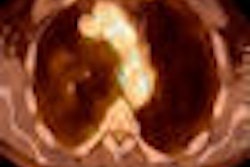Lung scintigraphy may be more reliable than pulmonary CT angiography (CTA) for identifying or excluding pulmonary embolism (PE) in pregnant patients, according to a study published in the November issue of the American Journal of Roentgenology.
Pulmonary embolism is the leading cause of maternal death in pregnancy. CTA is the imaging modality of choice for the diagnosis of pulmonary embolism; however, lung scintigraphy, a form of radionuclide imaging that produces 2D images, has been shown to produce better diagnostic-quality images more often than CTA in pregnant patients.
The study, led by Dr. Carole Ridge from St. Vincent's University in Dublin, Ireland, analyzed 28 CTA studies and 25 lung scintigraphy studies performed on a group of 50 patients. The results showed that lung scintigraphy is more reliable than CTA for the diagnosis of PE.
Only one of 25 lung scintigraphy studies was inadequate for diagnosis, compared with 10 out of 28 CTA examinations that were found to be inadequate. Exams were considered inadequate when poor image quality prohibited a diagnosis.
Lung scintigraphy is more reliable than CTA for diagnosing or excluding PE in pregnant patients, the authors concluded, and it should be considered the imaging technique of choice unless the CTA image technique can be optimized for the pregnant patient.
Related Reading
Ultrasound tops scintigraphy in gallbladder function evaluation, September 3, 2009
Pulmonary CTA finds more than pulmonary embolism in children, August 25, 2009
FDG-PET/CT trumps bone scintigraphy for young Hodgkin's lymphoma patients, June 30, 2008
Researchers scrutinize CTA for pulmonary embolism, July 16, 2007
CAD turns in mixed performance for pulmonary embolism, January 16, 2007
Copyright © 2009 AuntMinnie.com



















